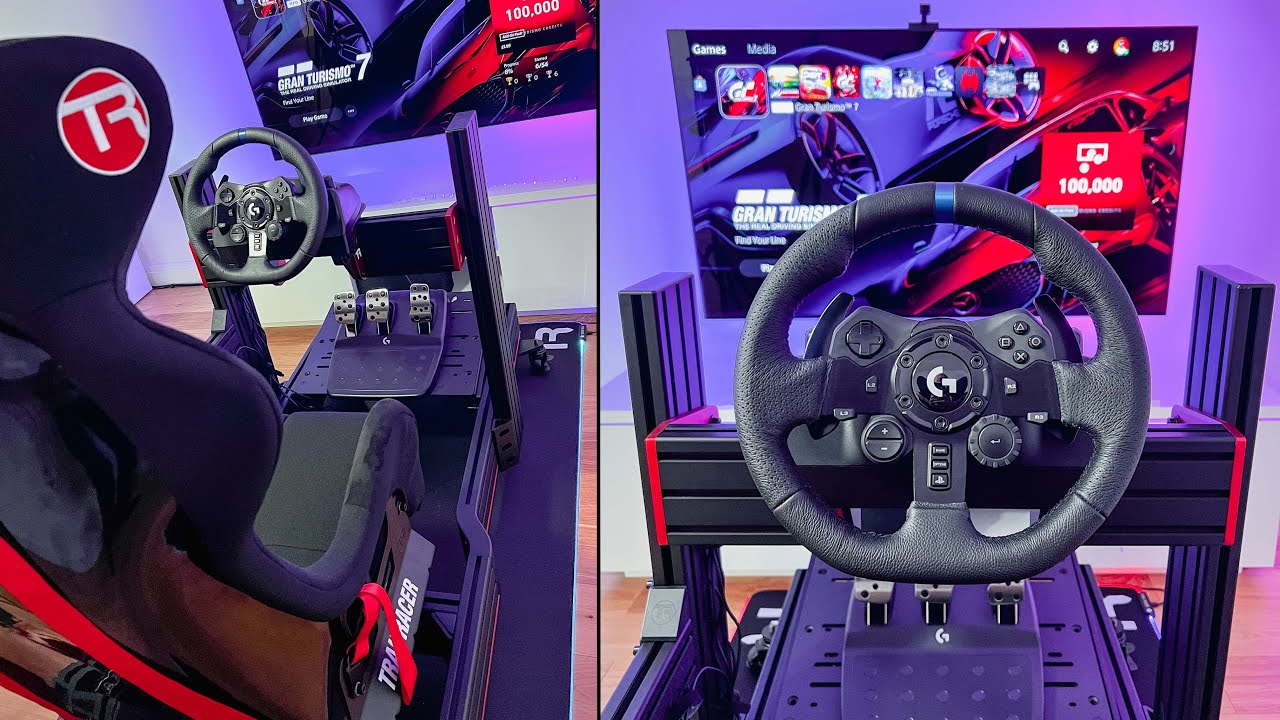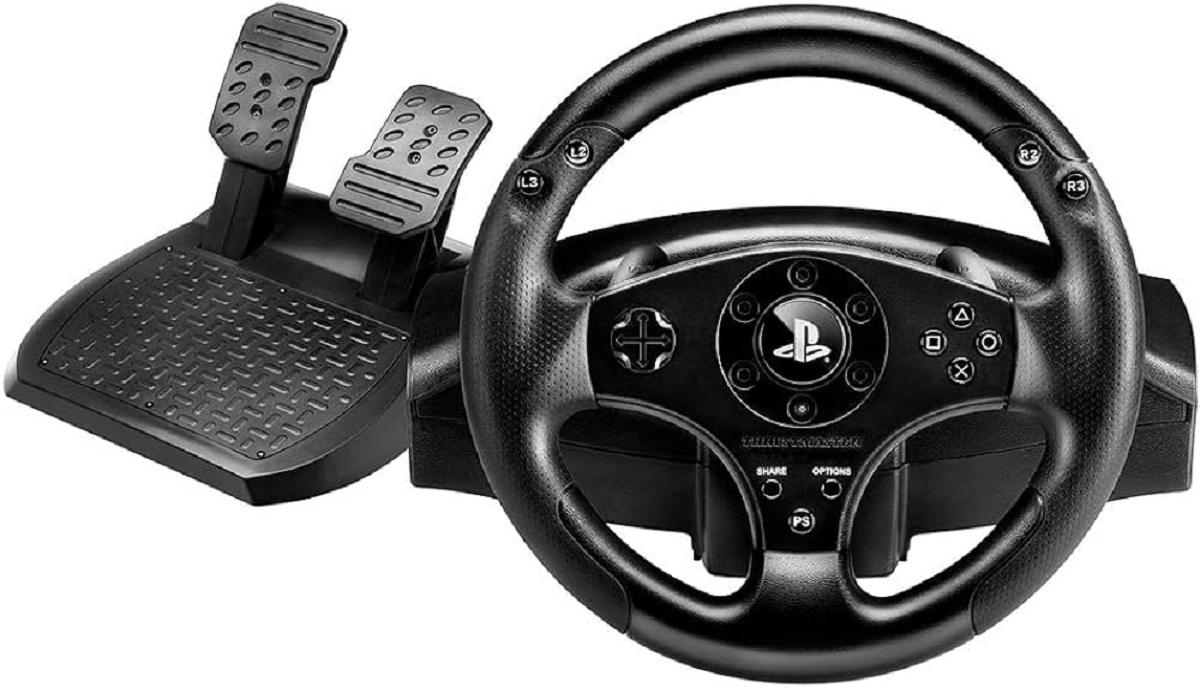Introduction
Getting Ready to Race
So, you've decided to take your Gran Turismo 5 experience to the next level by investing in a racing wheel. Congratulations! This decision will undoubtedly elevate your gaming experience, providing a level of immersion and realism that a standard controller simply can't match. However, setting up a racing wheel for Gran Turismo 5 can be a bit daunting, especially for first-timers. But fear not, as we're here to guide you through the process step by step.
In this comprehensive guide, we'll walk you through the entire process of setting up your racing wheel for Gran Turismo 5, from choosing the right wheel to fine-tuning the settings for the perfect racing experience. Whether you're a seasoned racing game enthusiast or a newcomer to the world of simulated racing, this guide will equip you with the knowledge and skills to optimize your racing wheel setup and get the most out of Gran Turismo 5.
Before we dive into the nitty-gritty details of wheel setup and configuration, it's important to emphasize the transformative impact that a racing wheel can have on your gaming experience. The tactile feedback, precise control, and immersive sensation of gripping a realistic steering wheel can transport you from your living room straight into the driver's seat of a high-performance race car. With the right setup, you'll feel every nuance of the road surface, every subtle vibration of the car, and every adrenaline-pumping turn as you navigate the challenging tracks of Gran Turismo 5.
So, grab your racing wheel, buckle up, and get ready to embark on an exhilarating journey toward the perfect racing setup for Gran Turismo 5. Whether you're aiming for competitive lap times or simply seeking the most immersive driving experience possible, this guide will help you unleash the full potential of your racing wheel and elevate your Gran Turismo 5 gameplay to new heights. Let's hit the track!
Choosing the Right Racing Wheel
Steering Toward the Perfect Wheel
When it comes to selecting a racing wheel for Gran Turismo 5, the choices can be overwhelming. From entry-level models to high-end, feature-rich options, the market offers a wide array of wheels tailored to different budgets and preferences. Before making a decision, it’s crucial to consider several key factors to ensure that the chosen wheel aligns with your gaming needs and preferences.
First and foremost, consider the type of racing experience you seek. If you’re a casual gamer looking to add a touch of realism to your racing sessions, a basic wheel with essential features such as force feedback and responsive steering may suffice. However, if you’re a dedicated enthusiast aiming for a more immersive and precise driving experience, a high-quality wheel with advanced force feedback, adjustable pedal sets, and additional programmable buttons may be the ideal choice.
Budget is another critical consideration. Racing wheels come in a wide price range, and while it’s tempting to opt for the most feature-packed model, it’s essential to strike a balance between functionality and cost. Assess your budget and explore the available options within that range, keeping in mind that a mid-range wheel with solid performance and essential features can deliver a satisfying racing experience without breaking the bank.
Ergonomics and build quality are equally important. A comfortable grip, durable construction, and realistic wheel size contribute to prolonged gaming comfort and a more authentic driving feel. Additionally, compatibility with your gaming platform is a non-negotiable factor. Ensure that the wheel you choose is fully compatible with your console, whether it’s PlayStation, Xbox, or PC, to avoid compatibility issues and maximize functionality.
Lastly, delve into user reviews and expert recommendations to gain insights into the performance, durability, and overall satisfaction levels of different racing wheels. Real-world experiences shared by fellow gamers can provide valuable guidance in making an informed decision.
By carefully evaluating these factors, you can confidently choose a racing wheel that aligns with your gaming style, budget, and quality expectations, setting the stage for an immersive and exhilarating Gran Turismo 5 racing experience.
Connecting the Racing Wheel to Your Console
Linking Up for Racing Excellence
Once you’ve selected the perfect racing wheel for your Gran Turismo 5 adventures, the next step is to seamlessly connect it to your gaming console. Properly establishing this connection is crucial for unlocking the full potential of your racing wheel and immersing yourself in the thrilling world of simulated racing. Here’s a step-by-step guide to help you link up your racing wheel with your console.
1. Check Compatibility: Before diving into the connection process, ensure that your chosen racing wheel is fully compatible with your gaming console. Whether you’re using a PlayStation, Xbox, or PC, verify that the wheel supports your specific platform to avoid any compatibility hiccups.
2. Power Up: Most racing wheels require an external power source to operate. Connect the wheel to a power outlet using the provided power adapter, and ensure that it’s receiving the necessary power supply to function optimally.
3. Connect to the Console: Depending on the type of racing wheel you have, the connection method may vary. For USB-based wheels, simply plug the USB cable into an available port on your console. If your wheel uses wireless connectivity, follow the manufacturer’s instructions to pair it with your console wirelessly.
4. Install Drivers (If Necessary): In some cases, certain racing wheels may require the installation of specific drivers or software to ensure seamless integration with your console. Visit the manufacturer’s website or refer to the product manual for guidance on driver installation and configuration.
5. Calibration and Configuration: Once the physical connection is established, it’s time to calibrate and configure the racing wheel settings. Access the console’s settings menu or the dedicated racing wheel software to fine-tune parameters such as wheel sensitivity, button mapping, and force feedback strength to suit your preferences.
6. Verify Functionality: After completing the setup, test the racing wheel’s functionality within Gran Turismo 5. Navigate through the game’s settings to ensure that the wheel is recognized and responsive. Make any necessary adjustments to optimize the wheel’s performance for an unparalleled racing experience.
By following these steps, you can seamlessly connect your racing wheel to your console, paving the way for an immersive and exhilarating racing experience in Gran Turismo 5. With the physical link established, you’re one step closer to conquering the virtual tracks with precision and finesse.
Adjusting Wheel Settings in Gran Turismo 5
Fine-tuning Your Racing Experience
With your racing wheel successfully connected to the console, it’s time to delve into the intricacies of adjusting the wheel settings within Gran Turismo 5. Fine-tuning these settings is pivotal in customizing the driving experience to suit your preferences and optimizing the responsiveness of the wheel for precise control on the virtual racetrack. Here’s a comprehensive guide to adjusting the wheel settings within the game:
1. Accessing the Settings: In Gran Turismo 5, navigate to the options or settings menu to locate the section dedicated to input devices. Here, you’ll find a range of adjustable parameters specific to racing wheels, including steering sensitivity, force feedback strength, and pedal calibration.
2. Steering Sensitivity: Adjusting the steering sensitivity allows you to fine-tune the responsiveness of the wheel to your input. Experiment with different sensitivity levels to find the setting that best aligns with your driving style. Lower sensitivity settings provide more precise control, while higher settings offer quicker steering response.
3. Force Feedback Strength: Gran Turismo 5 offers extensive customization of force feedback settings, allowing you to tailor the intensity of tactile feedback transmitted through the racing wheel. Experiment with varying force feedback strengths to find a balance that conveys the nuances of the road surface and enhances the immersive driving experience without being overly strenuous.
4. Pedal Calibration: If your racing wheel features pedal sets, ensure that the pedals are correctly calibrated within the game. This involves configuring the pedal input range to match your preferred sensitivity, providing consistent and accurate control over acceleration and braking during races.
5. Button Mapping: Gran Turismo 5 enables users to map specific in-game functions to buttons on the racing wheel. Take advantage of this feature to assign critical commands such as gear shifting, traction control adjustments, and camera angles to easily accessible buttons on the wheel, streamlining your control interface for seamless gameplay.
6. Test and Refine: After making adjustments, take the time to test the modified settings in practice sessions or test races within Gran Turismo 5. Pay close attention to how the wheel responds to your inputs and make further refinements as needed to achieve a setup that feels intuitive and enhances your overall racing performance.
By meticulously adjusting the wheel settings within Gran Turismo 5, you can personalize the driving experience to your liking, harness the full capabilities of your racing wheel, and elevate your immersion in the virtual racing world. With these settings finely tuned, you’re poised to conquer the challenging tracks of Gran Turismo 5 with unparalleled precision and control.
Fine-tuning Force Feedback and Sensitivity
Enhancing Realism and Responsiveness
One of the most critical aspects of optimizing your racing wheel setup for Gran Turismo 5 is fine-tuning the force feedback and steering sensitivity to strike the perfect balance between realism and responsiveness. These adjustments are pivotal in replicating the tactile sensations of real-world driving while ensuring precise control over your virtual vehicle. Here’s a detailed exploration of the process:
Understanding Force Feedback: Force feedback technology simulates the physical forces experienced during driving, translating them into tactile feedback transmitted through the racing wheel. In Gran Turismo 5, fine-tuning the force feedback strength is essential to accurately convey the road surface textures, tire grip, and vehicle dynamics, enriching the immersive driving experience.
Balancing Realism and Comfort: When adjusting force feedback settings, aim for a balance that authentically communicates the nuances of the driving environment without causing discomfort or fatigue during extended gaming sessions. Experiment with different force feedback strengths to find a setting that immerses you in the racing experience while remaining comfortable and manageable.
Refining Steering Sensitivity: Steering sensitivity directly influences the responsiveness of the wheel to your input, shaping the precision and agility of your virtual vehicle. Lower sensitivity settings offer finer control, ideal for subtle steering adjustments, while higher settings deliver quicker response, suitable for dynamic maneuvers. Finding the optimal sensitivity level is crucial for achieving a natural and intuitive driving feel.
Adapting to Track Conditions: In Gran Turismo 5, the diverse track surfaces and environmental conditions demand adaptable force feedback and sensitivity settings. Tailor these parameters based on the characteristics of each track, adjusting for variations in grip levels, surface textures, and cornering challenges to maximize your competitive edge and driving enjoyment.
Fine-tuning for Personal Preference: Every driver has unique preferences and driving styles. Take the time to experiment with force feedback and sensitivity settings, considering factors such as your preferred racing genre, desired level of challenge, and comfort during extended play. Customizing these settings to align with your individual preferences enhances your overall immersion and enjoyment of Gran Turismo 5.
By meticulously fine-tuning the force feedback and steering sensitivity settings, you can elevate the realism and responsiveness of your racing wheel setup, immersing yourself in the thrilling world of Gran Turismo 5 with unparalleled precision and sensory feedback. These adjustments not only enhance your competitive performance but also deepen your connection to the virtual driving experience, making every race a captivating and immersive adventure.
Testing and Tweaking for the Perfect Setup
Refining Your Racing Experience
As you approach the final stages of setting up your racing wheel for Gran Turismo 5, the process of testing and tweaking becomes instrumental in fine-tuning the setup to perfection. Through systematic testing and incremental adjustments, you can tailor the wheel’s performance to your preferences, ensuring an immersive, responsive, and highly personalized racing experience. Here’s a comprehensive approach to testing and refining your setup:
Initial Test Drive: Start by taking your virtual vehicle for a spin on a familiar track within Gran Turismo 5. Pay close attention to how the racing wheel responds to your inputs, including steering, throttle, and braking. This initial test drive serves as a baseline for identifying areas that require refinement.
Assessing Steering Response: Evaluate the steering response of the wheel during different driving scenarios, such as high-speed straightaways, sweeping corners, and tight hairpin turns. Determine if the steering sensitivity and force feedback strength align with your expectations for precision and realism, making note of any areas where adjustments are warranted.
Fine-tuning Force Feedback: Focus on the force feedback sensations transmitted through the wheel, assessing how effectively they convey the road surface textures, vehicle dynamics, and traction limits. Make incremental adjustments to the force feedback strength to achieve a balance that immerses you in the driving experience without causing undue strain or discomfort.
Pedal and Shifter Calibration: If your racing wheel includes pedal sets and gear shifters, ensure that they are calibrated to deliver consistent and accurate input. Test the pedals for smooth and responsive acceleration and braking, and verify that the gear shifts correspond seamlessly with your commands, refining the calibration as needed.
Iterative Adjustments: Implement incremental adjustments to the steering sensitivity, force feedback strength, and other customizable parameters based on your test drive observations. Small, iterative changes allow you to methodically refine the setup without overwhelming the overall feel of the wheel, leading to a more organic and personalized configuration.
Extended Play Testing: Engage in extended play sessions to assess the comfort and ergonomics of the racing wheel setup over prolonged periods. Pay attention to any discomfort, fatigue, or ergonomic issues that may arise, making further adjustments to enhance your overall gaming comfort and endurance.
By methodically testing and tweaking your racing wheel setup, you can iteratively refine the configuration to align with your unique preferences and driving style, culminating in a setup that delivers the utmost immersion, responsiveness, and enjoyment in Gran Turismo 5. This iterative approach empowers you to tailor the setup to your exact specifications, ensuring that every race is a captivating and exhilarating experience that reflects your individuality as a virtual racing enthusiast.

























